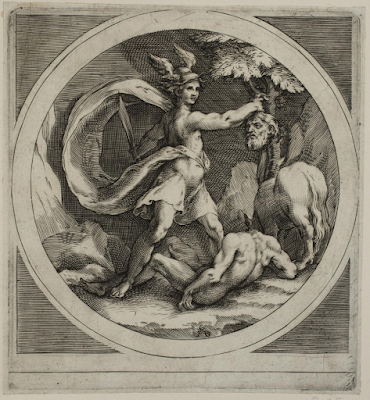 |
| Richard Bird Danton's Death by Georg Büchner at the National Theatre, London 1982 poster (severed head by Théodore Géricault) Victoria & Albert Museum, London |
 |
| Bjørn Ransve Head in the Style of David 1977 oil on panel National Gallery of Norway, Oslo |
 |
| Odilon Redon Head within an Aureole 1893-94 pastel and charcoal Getty Museum, Los Angeles |
 |
| William Kentridge Braz Cubas (Head and Stone) 2000 lithograph Yale University Art Gallery |
 |
| François Chifflart Perseus with the Head of Medusa ca. 1870-80 etching Clark Art Institute, Williamstown, Massachusetts |
 |
| Nicolai Abildgaard Personification of Philosophy 1800 oil on canvas Statens Museum for Kunst, Copenhagen |
 |
| Anonymous Italian Artist after Polidoro da Caravaggio Mercury with the Head of Argus ca. 1595 engraving Philadelphia Museum of Art |
 |
| Giulio Romano Hercules resting after slaying the Hydra ca. 1535 drawing Getty Museum, Los Angeles |
 |
| attributed to Giovanni Benedetto Castiglione (il Grechetto) Still Life with Ram's Head ca. 1650 oil on canvas Museo del Prado, Madrid |
 |
| Charles Albert Waltner after Constant Troyon Tête de Bélier Mort ca. 1873 etching Philadelphia Museum of Art |
 |
| Riccio (Andrea Briosco) Meleager presenting the Boar's Head to Atalanta ca. 1515-30 bronze plaquette National Gallery of Art, Washington DC |
 |
| Jean Fautrier Fish Heads ca. 1927 oil on canvas Albright-Knox Art Gallery, Buffalo, New York |
 |
| Michael Willmann Beheading of St Paul 1661 etching Staatsgalerie, Stuttgart |
 |
| Jakob Frey after Giovanni Passeri Initial D with St Denis as Cephalophore ca. 1715 engraving Cooper Hewitt, Smithsonian Design Museum |
 |
| León Ferrari Untitled (series, L'Osservatore Romano) 2001 digital print Tate Gallery |
"Cephalophory (post-decapitation ambulation) and cephalology (post-decapitation locution) . . . highlight both the effectiveness of the relics and the saint's selection of the locus of his or her cult. By translating his or her own head (and by extension, the rest of the body) to a self-ordained location, a cephalophoric saint selects the spot at which he or she wishes to be buried and venerated. In doing so, the cephalophore essentially initiates and localizes the cult of his or her own relics. Thus, the hagiographic trope of cephalophory, and the related miracle of cephalology, do more than provide a dramatic tale of martyrdom. They concentrate attention on the cult of the saint's relics by revealing the power of the relics, the location at which they may be found, and the manner of their veneration."
– Scott B. Montgomery, Securing the Sacred Head: Cephalophory and Relic Claims, published in Disembodied Heads in Medieval and Early Modern Culture, Verlag Ferdinand Schöningh (distributed by Brill), 2013
 |
| Anonymous British Artist Beheading of King Charles I ca. 1649 oil on canvas Scottish National Portrait Gallery, Edinburgh |